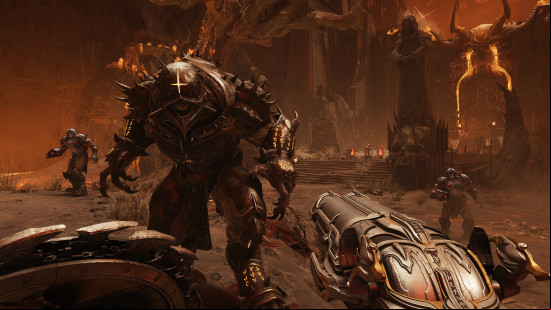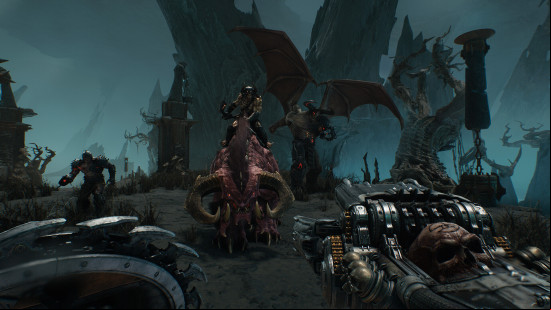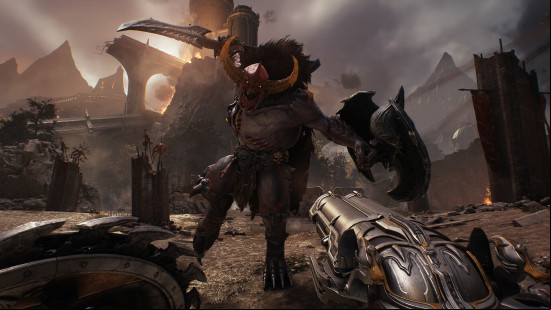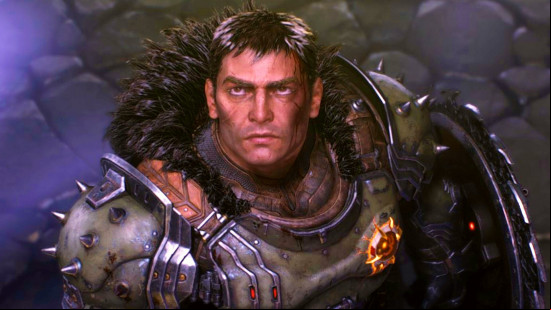"You're a space marine, one of Earth's toughest, hardened in combat and trained for action. Three years ago you assaulted a superior officer for ordering his soldiers to fire upon civilians. He and his body cast were shipped to Pearl Harbor, while you were transferred to Mars. With no action for fifty million miles, your day consisted of suckin' dust and watchin' restricted flicks in the rec room."
That's our introduction to Doomguy, in the instruction manual that accompanies the original game from 1993. Doom doesn't have any cutscenes or dialogue. In of a narrative, each episode ends with a short age of text summing up what you've just done and teasing the next location you're about to enter, and that's all. But the eponymous hero of id's greatest shooter nevertheless has character. When his nose and teeth are bloodied, Doomguy soldiers on regardless, one brow raised, hungrily looking for fresh meat. When he finds a new, big gun, he grins, bares his teeth – he can't wait to kill something with this.
In the new version of Doom, released in 2016 by the also-new version of id Software, there's a greater effort to characterize and define Doomguy. During the prologue, when Samuel Hayden remarks to him that everything the UAC does is for the "benefit of humanity," and Doomguy glances down at the half torso of the former maintenance man, it establishes his indignation, a righteous anger. When Hayden instructs Doomguy how to safely disable the Argent generators, and begs him to power them down gradually, and then Doomguy just smashes them to pieces with his fist and his boot, it tells you that he's uncompromising, and all about simple, brute force.

But the Doomguy of 2016 works so well because of one other slight ingredient in his character. Take that moment where he needs to access the computer, and the screen can only be unlocked using the fingerprint scanner. He looks around, sees the leftovers of a dead UAC engineer, picks them up by the arm, and pushes their hand onto the glass. If you find one of the hidden toy collectibles, Doomguy will examine it for a second and then give it a little fist bump. Die by falling into the lava, and as he sinks, he'll do the Terminator 2 thumbs up. In the original Doom, when you pick up the chainsaw, the game urges you to "find some meat." The Doomguy of 2016 is just as playful and anarchic. The best thing about this character, at least in these incarnations, is that he's enjoying himself as much as you are.
And this isn't some marginal, extra bit of color that id puts in just for a couple of laughs – beginning in 1993, and then with variable success throughout its history, Doom has achieved what I think is generally considered one of the hardest things in game making, which is harmonising the writing with the gameplay, or more specifically, characterizing the playable hero in such a way that the characterization fuels the gameplay, and the gameplay, in turn, embellishes and affects the characterization.
An example of a game that does this badly is Red Dead Redemption. John Marston is the mournful ex outlaw who wants nothing more than to be reunited with Abigail and Jack, but in the hands of the player, rather than completing the jobs that actually bring him closer to his wife and son, John can spend dozens of hours picking flowers in the wilderness, helping strangers with their errands, and kidnapping nuns and blowing them up with sticks of dynamite. It's an old question – Clint Hocking coined the term ludonarrative dissonance in 2007 – but even though it's become a game design and game criticism cliche, the problem is still unresolved.

Doom 2016 is one of the rare mainstream videogames where character as written and character as played match and inform each other. It helps that Doomguy, from a biographical and psychological point of view, is very simple – he's good at killing the demons of Hell, and he really likes killing the demons of Hell. Nevertheless, a lot of the mechanics and inventions of gameplay in Doom 2016 are engineered towards that characterization. Doomguy is motivated by his hatred for the monsters. When you kill a monster in an especially gruesome way, via the Glory Kill system, you get a bigger drop of health and armor. Cutting one in half with the chainsaw refills the ammunition for your guns. And so, the more that Doomguy's anger and viciousness are expressed, the more that anger and viciousness are fueled – killing catalyzes killing; his character incentivizes you to play in a way that develops the character.
Doom Eternal spends more time extrapolating the history and personality of Doomguy, by now fully re-designated as the Doom Slayer. Combat, movement, and levels are also more complex and designed; certain enemies are only weak to certain guns, navigation often means puzzle solving, and there's a more elaborate system for upgrades, as well as a mid-mission hub. This all creates a twofold problem. Firstly, with more Doom Slayer lore on its shoulders, id also has more character to try and work into the gameplay – that simple dynamic of 'he likes killing demons, so killing demons is fast and fun' is complicated by the Slayer's expanded persona.

Secondly, even if Doom Eternal were to strip the character back down again, a lot of what the player does would still feel contrary to the Slayer's behavior and essence. He's not fussy. He's not fastidious. He's not cerebral. But the gameplay of Eternal demands micromanagement and precision. If the Doom Slayer wants to get over a wall, he has to stand on a button to release a block, then push the block into the right position, and then time a jump so he hits three power-ups in mid-air. The Doomguy of 1993 and 2016 just blows up the wall.
Those two games are pure expressions of a simple character. Eternal on the other hand needlessly tries to make the character more complex, and the mechanics are overdesigned in an effort to match – but it's attempting, at least, a different interpretation of the game and its protagonist. And now there's Doom The Dark Ages, which is more of a mixed success. The gameplay of The Dark Ages feels spiritually truer to Doomguy, insofar as it's all about raw, stubborn power. You tank damage with the shield. You extract ammunition and other supplies from enemies by smashing them with a flail; authentic to Doomguy's unyielding aggression, this time, you don't even have to take the tiny cognitive step to trigger a Glory Kill. There's very little platforming, and enemies rarely attack either from above or below you.

In the original Doom, all the action is on a single, horizontal plane because the game's engine doesn't accommodate a Y axis. In The Dark Ages, it's because a flat battlefield is a better stage for Doomguy and the player to perform on, a more suitable showcase for the game's blunt-force combat. Mechanically, The Dark Ages feels like the best expression of Doomguy's legend: you are lethal, crude, and you don't take a single step back. It may still be needlessly involved (Doom 2016 feels 'basic' and free, in a way that matches Doomguy's savageness and wilfulness) but, compared to Eternal, The Dark Ages is not intricate. It captures a crucial part of the character, and with that, something fundamental to the essence of Doom.
But that's undermined by the greater aesthetic, and the script. Eternal's ultra-colorful, throwback, almost toyish visual design keeps alive that playful, rogueish element of both Doom, as an entity, and its central character. But, barring a couple of choice sections, the world of The Dark Ages is steeped in medieval brooding. Doom has never been wacky, but it's also never been self-serious. The Dark Ages is a miserable game to look at. All the characters are stony-faced, and speak to one another with a meaningful, clipped gravitas. It rains all the time. The Baron of Hell is brown instead of red, and the Cacodemon Hybrid looks like its dour cousin from Doom 3.

And of course, Doomguy is now a part of the Knight's Sentinel. He has companions. He's on a team. Part of what makes that character, and the games where you play as that character, so thrilling is that they make you feel like a disruptive singularity. 'The only thing they fear is you.' It's Doomguy, unrestrained by anyone or anything, doing it all his own ultra-violent way.
At the end of The Ancient Gods, when the Dark Lord asks Doomguy if he has anything to say to his creator, before he kills him, he simply replies, 'no.' It's the perfect moment of defiance, flatly refusing to be pulled into any greater meaning, determined to do what he wants, how he wants. By contrast, in The Dark Ages, even when he's freed from the Maykr's control, Doomguy spends a lot of time doing what other people say, towards the Sentinels' shared objectives. He doesn't have the renegade energy that makes his character, and the gameplay that builds his character, feel so vigorous.

Nevertheless, The Dark Ages is another attempt by id to find a different variation on Doom and its hero. After Doom 2016, the studio could, quite reasonably, have released two sequels that only attempted and provided more of the same. While the alternate interpretations of Doom in both Eternal and The Dark Ages feel variously contrary to the game's spirit, they're both worthy explorations – the fact that The Dark Ages, which is the third in this pseudo reboot trilogy and the seventh Doom overall, not only tries but also occasionally succeeds in producing something fresh is still an achievement.
You can read our full missions guides to help you get started.
